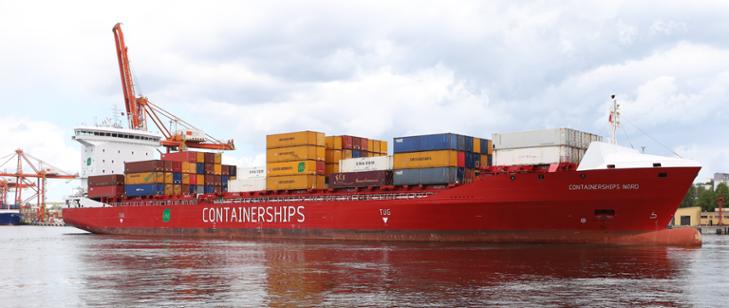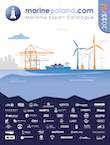
The maritime industry is the bloodstream of the global economy. For this reason, it was one of the first to feel the effects of the global spread of the COVID-19 epidemic and the restrictions that followed, in particular the closing of borders. Data from the first quarter of this year. give an approximate picture of how the pandemic affected the industry and its individual segments.
MARITIME TRANSPORT
Maritime economy is one of the most fluctuating in international trade. Economic activity in ports reflects ongoing changes.
Ports are a critical element of the global economy as a link between elements of global production and supply chains. Hence, maintaining their operational capabilities during a pandemic is critical.
In the era of a pandemic, ports face numerous disruptions: the limited crew translates into reduced reloading capacity, in many ports ships must be quarantined for many days before entering, delays interrupt the regularity of international shipping services and stability of supply chains.
The World Trade Organization (WTO) estimates that in 2020 the value of international trade will fall by between 13% and 32%. In terms of industry, the negative trend is reflecting in the business activity index at the Clarkson Port Call Activity Tracker, which noted decrease in the number of ships calling at ports in March this year by 2.3% yoy.
Maritime transport as a binder of the global economy
Maritime transport is responsible for transporting nearly 80% of the volume and 70% of the value of international trade, including key goods such as food and fuels; joins together individual elements of global production and supply chains, which generate 64% of global GDP.
Unlike many other sectors of the economy, the maritime transport sector has not been paralyzed or frozen as a result of restrictions introduced by individual countries to counteract the spread of the virus, as maintaining its smooth functioning is critical for the functioning of the state, economy and society.
Operational disruptions
Unprecedented restrictions caused operational disruptions and led to a dysregulation of freight.
The measures taken by individual countries to prevent the spread of the coronavirus epidemic have severely affected the operational capabilities of ports and freight agencies. On the one hand, the lockdown strategy resulted in crew reductions in ports, on the other hand, ships entering the port were a subject to numerous restrictions, among which the most important were the mandatory two-week quarantine in the sea zone and the inability to replace the crew due to closing external borders or having to submit to long-term quarantine. These factors have led to serious delays in maritime transport on the export side and congestion in unloading and receiving deliveries on the import side, leading to further disruptions in the supply chain.
As a result of the freezing of economic activity in China, the bulk segment was particularly affected, whose BDI index fell to a historical minimum of 50 points in February, although it rebounded with the restart of production at the "world factory." As a result of the pandemic and the freezing of tourism, the passenger ship segment almost froze.
The COVID-19 pandemic has affected the shipbuilding industry on three levels: operational capacity, supply chain and demand.
The picture, which is drawn from the data for the first quarter of this year, reflects the problems primarily of Chinese shipyards. Nevertheless, European industry will be facing similar challenges.
2020 will be a year of uncertainty for the industry. Nevertheless, the length of the investment process in the maritime industry means that after a short-term shock, there will be stabilization resulting from long-term forecasts, and hence - investments calculated for an economic recovery from 2021.
Restrictions on movement introduced to counter the spread of the epidemic have had the most immediate impact on the shipping industry, disrupting production capacity. On the one hand, it drastically hindered access to employees, often forcing shipyards to suspend production for the sake of crew safety. On the other hand, restrictions at international level, in particular closing borders, paralyzed supply chains and hampered access to specialized equipment.
The global spread of SARC-CoV-2 coronavirus in the following weeks has also forced production to be stopped in major European shipyards, including in Italy, France, Spain and Germany. It wasn't until May, after a break of over a month, that the leading shipbuilding groups began the process of resuming operations.
As a result, in the first quarter of this year, the value of units delivered ped by 14% in dwt terms and as much as 24% in terms of CGT - the unit indicating the level of complexity of the unit and the labor intensity of its production - y / y. (325 units with offset gross capacity of 7.2 million CGT). The clarkson Research Service analytical company, authoritative for the maritime industry, forecasts that in annual terms ship production may fall by up to 25% dwt y / y.
The situation of the European shipbuilding industry, operating on the basis of the continental supply chain, is further complicated by the difficulties posed by the development of a harmonized plan between Member States for opening intra-Community borders and restarting the Schengen area.
Even more serious and far-reaching in consequences is how the pandemic affects the demand from shipowners. Already in 2019, the level of new orders reached a 15-year minimum. In the first quarter only this year the new orders portfolio shrank by as much as 56% y/y. (184 units worth USD 5.5 billion); even more, as much as 71% in terms of CGT. While the declines caused by the global financial crisis of 2008 were nominally even higher, reaching 80-90% y/y, the current situation is all the more severe because the oversupply of the merchant fleet from the turn of the first and second decades of the 21st century - removal of which was the main factor in the abovementioned deep declines in orders in 2010's - it has been almost completely leveled to this day.
The prospects of the portfolio of orders are raised by concerns about the state of the global economy after the health crisis and limited availability of investment financing from banks, which in times of crisis tend to reduce lending even despite lowering interest rates and the money supply by central banks.
From a shipowner's perspective, a pandemic is not the only factor of uncertainty. They put on hold new orders also due to the uncertainty about the choice of propulsion and fuel technology in view of the expected further tightening of emission standards in international shipping. Meanwhile, the pandemic forced the International Maritime Organization (IMO) to cancel and postpone to indefinite date the 75th session of the Marine Environment Protection Committee (MEPC), scheduled for March, at which key decisions on short-term measures to reduce emissions from ships were to be made.
The accumulation of business factors of uncertainty is also superimposed on the practical dimension: many restrictions on travel diametrically impede the finalization of conversations and placing orders.
Maritime transport is one of the most susceptible to international trade fluctuations in maritime industries. Time and a rebound in the global economy in 2021 will be the key for this industry. Meanwhile, in 2020 the World Trade Organization (WTO) predicts a decline in international trade value of between 13% and 32% (during the global financial crisis of 2008 the decline was 9% ), and Clarkson Research Service forecasts a decrease in the volume of international maritime trade by 11%.
The entire investment cycle related to the construction of the ship is a period of about 2-3 years, even longer for more complex units. Such investments are therefore calculated for years, and exogenous shocks translate more into postponing rather than giving up orders; therefore, stability should be expected in the medium term. Currently, the losses incurred can be an offset to some extent by the inflow of countercyclical and even speculative orders, calculated on - forecast by leading international and national financial institutions - a strong rebound of the global economy from 2021.
In terms of the renovation and modernization specialization of the Polish shipbuilding industry, the overall decline in investment in new vessels may translate into a greater demand for modernization of existing vessels, in particular the passenger ships segment, the need for deep modernization as part of adapting e.g. to expected stringent sanitary standards.


